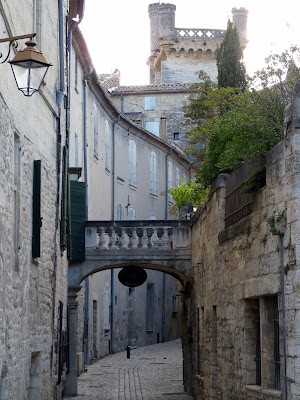 |
| Inside the amphitheater in Arles |
After my parents concluded their visit to Provence, we stayed in the area to do some more sightseeing. Our first stop was Arles, an ancient city dating back to about 800 BCE with Ligurian, Celtic, and Phoenician roots. Arles was an important city during Roman times, and served as a cultural, religious and military center during the late Roman Empire. The Roman ruins that remain span five centuries (1st century BCE to 4th century CE) and include an amphitheater (also referred to as an arena), a theater, baths, a large necropolis, a network of ancient subterranean passageways, an aqueduct and water mill, and an obelisk.
Arles had a second golden age during medieval times, and is cited as one of Europe's leading examples of the appropriation of a classical city by a medieval society. Arles' most important medieval monument is the Church of Saint Trophime, a prime example of Provençal Romanesque architecture. Given the city's significance through numerous historical epochs, it's ironic that the reason Van Gogh moved to Arles (where he resided in 1888-1889 before moving on to Saint Rémy) was that it was a quiet backwater, as the recent arrival of the railway had killed off the city's once-vital river trade. In more recent times, Arles has been revived as a major tourist destination and regional market town.
 |
| Another shot from inside the amphitheater |
 |
| At the Roman theater |
 |
| Exploring the Roman theater, with "modern" Arles in the background |
 |
| The amphitheater in Nîmes |
Only a half-hour from Arles, Nîmes' history goes back to the 4th millennium BCE, when semi-nomadic peoples cultivated the land here. Nîmes prospered in Roman times, reaching a population of 60,000. But its prominence faded in favor of Arles during the 4th and 5th centuries.
The most noteworthy sight in town is the best preserved Roman amphitheater in France, which was built around 100 CE to seat 24,000 spectators. It was used for housing in medieval times and lives on today as a sporting and cultural venue, hosting everything from bullfights to rock concerts (Carlos Santana was on the 2011 summer schedule when we were there). Another famous sight is the Maison Carrée, which is said to be one of the best preserved Roman temples in the world. The temple was rededicated as a Christian church in the 4th century, which spared it from destruction. It subsequently served as a meeting hall for the city's consuls, a stable for government-owned horses during the French Revolution, and a storehouse for the city's archives.
Nîmes' prosperity, however, was not confined to Roman times. It had a thriving textile industry by the early 1700s, and according to one theory, the word "denim" comes from "de Nîmes" (which means "of Nîmes"), as Levi Strauss used the local cloth to make his famous trousers. Like many of its Provençal neighbors, Nîmes offers different layers of history to the visitor - with a host of pretty churches, gardens, squares, and graceful old buildings.
 |
| Maison Carrée, Nîmes |
 |
| Talia's got her eye on that carousel! |
 |
| Eden in front of the amphitheater |
 |
| Place aux Herbes, Uzès |
This post concludes in Uzès, a small stately town near Nîmes. The city's most famous landmark is the Tour Fenestrelle (which means "Tower of Windows"), an 11th century Italianate church tower that looks like it's got a bit of a tilt - hence the comparisons to the Leaning Tower of Pisa. There's also a lovely castle (the Chateau du Duché), which sits atop an old Roman encampment and displays a surprisingly harmonious ensemble of architectural styles from the early Middle Ages to 18th century Baroque. There's also the graceful, tree-lined Place aux Herbes, one of several beautiful old squares in town. And just down the road, there's the Pont du Gard, a spectacular three-tiered Roman aqueduct that was used to transport water to Nîmes. We didn't get a chance to go this time (although we did visit with Jeremy in 2004).
Uzès was known - at least during certain periods of history - for its civilized and tolerant urban life. Jews settled here as early as the 5th century, there was a small community of Jewish scholars in the 13th century, and apparently the town had Jewish mayor in the 19th century. But alas, I don't think there are any Jews living here today.
Our next post will take us to four more sights of Provence: the beautiful and timeless hill towns of Gordes, Roussillon, Bonnieux, and Les Baux-de-Provence. Stay tuned...
 |
| Pont du Gard (we didn't go this time - photo taken from the internet) |
 |
| Marc and Jeremy at the Pont du Gard in 2004 |
 |
| Shot from the road, just outside Uzès |
 |
| More from Arles |
 |
| From inside the amphitheater, with medieval church in the background |
 |
| Inside the amphitheater |
 |
| The amphitheater from the outside |
 |
Frédéric Mistral
19th century lexicographer of the Occitan language, a Latin tongue whose closest relative is Catalan |
 |
| St. Trophime facade |
 |
| St. Trophime Cloister |
 |
| More from Nîmes |







































No comments:
Post a Comment